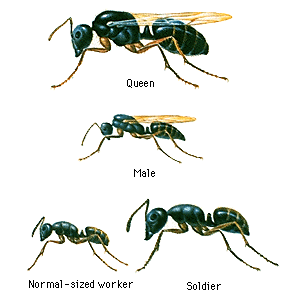As my college graduation approaches, I can’t help but feel a little nostalgic about those high school days, back when I knew exactly what I wanted to do and where I would be in a year. But then I remember that high school also came with cliques and all that “social hierarchy” crap. There’s a reason why every girl under the age of 30 has the entire Mean Girls movie memorized, right? Because it’s so accurately reflective of our own teen experiences. But just as every high school has its Regina George, the rest of the animal kingdom also has its share of “queen bees.”
Within the insect order of Hymenoptera (consisting of ants, bees, and wasps), there is also a social hierarchy in which queens carry out the reproduction for the colony, while most female workers remain sterile to help the queen raise her offspring. But why would female workers give up their own reproductive abilities to help the queen?
Well, the answer depends on whether communication between colony members is honest or manipulative, something that is highly debated in the scientific community. The queen signaling hypothesis suggests that queens emit chemicals as honest indications of their fertility, sort of like how a woman’s growing belly is a sign that she’s pregnant—she can’t fake it or control it. Female workers then respond to the queen’s signals by remaining sterile because it is in their own best interests to do so, either because reproducing is energetically costly or because females can get attacked for laying their own eggs, which is known as policing. The queen control hypothesis suggests that queens maintain their dominance because their chemical emissions actively suppress or manipulate the development of ovaries in workers.
In a study recently published in the journal of Evolution, a team of researchers tried to settle the debate over the two hypotheses by studying colonies of the Saxon wasp (Dolichovespula saxonica), a highly social species in which many female workers have active ovaries even in the queen’s presence. The researchers predicted that if queen control were occurring, they would see a queen-worker arms race, where female workers should evolve to be unaffected by the queen’s chemical emissions because it’s in their best interest to reproduce. This would then cause queens to also evolve their chemical compounds in order to stay one step ahead of the workers and maintain their reproductive dominance. This evolution would be ongoing, and could lead to highly complex chemical signal compositions that are unique to that particular species. On the other hand, if queen signaling were occurring, the researchers would expect to see much slower evolution rates and therefore chemical signal compositions amongst different species would be more similar. Queen signaling would also result in higher worker reproduction levels if there were less policing going on.
The researchers looked at the patterns of these things called cuticular hydrocarbons (CHCs), which are compounds made up of different arrangements of hydrogen and carbon atoms found in the cuticle, or outer exoskeleton of the wasps. These CHCs are the source of the chemical signals and the researchers found that there is a difference in the CHC patterns of fertile versus sterile wasps. Previous studies have also concluded that CHC patterns in other species are often just byproducts that form as hydrocarbons are transported to the developing ovaries. These findings suggest that CHC patterns are an honest signal of fertility. This study also found that worker reproduction rates increased as the queen aged and her fertility decreased, which would lower the need for policing. The study also compared the CHC patterns of the Saxon wasps to other wasp species and found that queens across species had a large number of similar CHC components, which indicates that evolution of chemical signals has been slow. These results are all similar to what was predicted for the queen signaling hypothesis over the queen control hypothesis.
Although the results of this particular study strongly support the queen signaling hypothesis, future research will have to replicate this study using other social Hymenopteran species. This will give us a better idea of how these signals evolve and if they’ve evolved the same way across species.
So can this study be applied to the “queen bees” in our own lives? Are they only admired because of some special chemical signals that they put out? Probably not. But it’s nice to know that we have the ability to become our own leaders and reject those we don’t support—a power that not all species have.
Reference: Zweden, J. S., Bonckaert, W., Wenseleers, T. and d’Ettorre, P. 2014. Queen signaling in social wasps. Evolution 68(4): 976-986.





